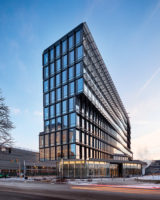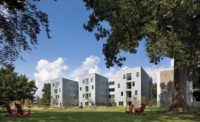Deborah Berke Partners Relaunches as TenBerke




Architects & Firms
New York–based Deborah Berke Partners has announced that it is becoming TenBerke and rearticulating the practice’s ethics-based vision. Alongside partners Maitland Jones and Arthi Krishnamoorthy, Deborah Berke spoke with RECORD senior editor Leopoldo Villardi about the change, what it means for the 60-person firm, and her forthcoming book with Thomas de Monchaux, Transform: Promising Places, Second Chances, and the Architecture of Transformational Change.
You’ve been practicing since 1982 and formed Deborah Berke Partners with Maitland Jones and Marc Leff in 2002. Just a few years ago, eight more designers, including Arthi, joined the partnership. Why the name change and what does it mean for your practice?
Arthi Krishnamoorthy: We’ve been thinking about it for some time—and it’s nice to finally say it aloud to an audience that isn’t just us. In a way, we are catching up to who we’ve been for a long time and finally using our firm name to better reflect that. Deborah doesn’t draw a napkin sketch and then walk away. Design has always been a conversation, amongst ourselves and with the creatives we often work alongside.
Deborah Berke: The firm has morphed over many years. When I first got my license, I was practicing at my kitchen table. It was a tiny, tiny office. Almost all our work was either in Seaside, Florida, or low-budget projects in New York City for artists. By the 2000s, we were taking on larger-scale work. But since the very beginning, we’ve never had the—I’ll call it “imperial” model. I am not an empress. I am never the only one talking. That’s just not how we work. Nor is it how we present ourselves to the world or how we relate to our clients.
Maitland Jones: We want to be clear about who we are and what is best for us as a group, with an interest in inclusion, empowering young people, giving them a sense of their future, and ensuring our longevity as a firm.
There are more than 10 partners, so where does the “Ten” come from?
AK: For us, Ten signified multiples and multiplicity. There are also the powers of 10, which evoke the many scales where we work—zooming in on details but also zooming out and thinking about the broad responsibilities we have as architects. Details, in the end, affect people.
MJ: It has very positive allusions to both 1960s optimism and architectural pragmatism. Does it contain a little whimsy or optimism? Maybe. It’s not too self-important, but it isn’t unserious either. Sometimes we think of ourselves as instruments of change. So there is something a little scientific about it, but also humanistic at the same time—10 fingers, 10 toes.
In recent years, principals have avoided using their own names, leading to some bizarre and forgettable firm names. Unlike Skidmore, Owings & Merrill’s shift toward SOM, or Polshek Partnership’s rebranding as Ennead, which removed its founder’s name altogether, “Berke” is still very much a part of the new identity.
DB: I’m not going anywhere. [Laughs.]
MJ: We’re moving toward a model of broad ownership, guided by narrow leadership. Clients come to us because they are undertaking projects that solve problems at a mission scale. They are not undertaking trivial things. This is the case with our new project at Princeton. These are the kinds of projects that are fun and exciting for us. We want to invoke all of this in our identity.
Many institutions have hired you for adaptive-reuse projects. Tell me a little bit about the thinking behind your forthcoming book, Transform, which documents these interventions. Deborah, your essay in it, “Against Preservation and for Regenerative Reuse,” will raise eyebrows among some.

Deborah Berke and Thomas de Monchaux’s forthcoming book will be published in June by Monacelli.
DB: That’s good. I have always been suspicious of the “save it as though it were in amber” approach, because life isn’t like that. Our bodies age. Our experiences change. Cities themselves are organic things that evolve over time. Why would you freeze a building in time? I can understand why someone would want to preserve a room where, say, George Washington slept. But beyond that, what we ought to speak to is that human experience changes, varies, and gets richer by the visibility of time—not of aging—but of time; of how we change uses and do things differently.
AK: In terms of climate change, we’re almost at a point of no return, too, and there is so much embodied energy in existing buildings. We risk losing our sense of optimism if we don’t do anything. There are many reasons to save what already exists.
MJ: Not least of which is to live in and acknowledge one’s time. Consider the Richardson Olmsted Campus in Buffalo. By adapting it and clearly adding to it, we leave no uncertainty about what the real deal is. If our additions had been Richardsonian Romanesque, I think everyone would’ve lost something.
DB: The space—and time—between old and new is where we live our lives. We are not of the tear-it-down-and-start-with-a-blank-slate school, but “fakery” is antithetical to our design approach. Dyed-in-the-wool preservationists need to be more open to discussions with architects about the key characteristics of a building that allow it to tell a story, and what the pieces are that otherwise can and need to change.





